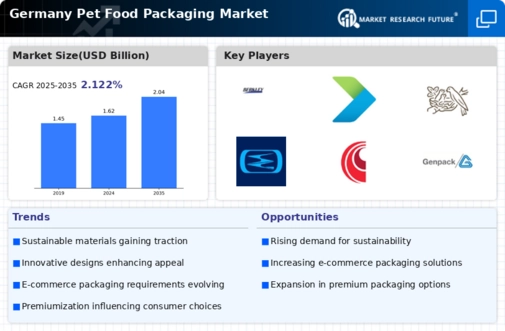Rising Pet Ownership
The pet food-packaging market in Germany experiences a notable boost due to the increasing trend of pet ownership. Recent statistics indicate that approximately 47% of households in Germany own at least one pet, with dogs and cats being the most popular choices. This surge in pet ownership correlates with a heightened demand for diverse pet food products, consequently driving the need for innovative packaging solutions. As pet owners become more discerning about the quality and variety of food they provide, the packaging must reflect these preferences. The market is likely to see a shift towards packaging that emphasizes freshness, convenience, and sustainability, aligning with consumer expectations. This trend suggests that the pet food-packaging market will continue to expand, as manufacturers adapt to the evolving needs of pet owners and their furry companions.
Health and Wellness Trends
The pet food-packaging market is significantly influenced by the growing focus on health and wellness among pet owners in Germany. As consumers increasingly prioritize the nutritional value of pet food, there is a corresponding demand for packaging that highlights these health benefits. For instance, packaging that clearly communicates ingredient sourcing, nutritional information, and health claims is becoming essential. This trend is reflected in the market, where premium pet food products, often accompanied by sophisticated packaging, are gaining traction. Reports suggest that the premium segment of the pet food market is expected to grow at a CAGR of around 5% over the next few years. Consequently, the pet food-packaging market must evolve to meet these demands, ensuring that packaging not only preserves product integrity but also serves as a marketing tool that resonates with health-conscious consumers.
Consumer Demand for Convenience
The pet food-packaging market is increasingly shaped by consumer demand for convenience. Busy lifestyles and the desire for easy-to-use products are prompting pet owners to seek packaging that simplifies feeding and storage. Single-serve packaging, resealable bags, and easy-pour designs are becoming more prevalent as they cater to the needs of modern pet owners. This trend is particularly evident in urban areas, where space constraints and fast-paced living necessitate practical solutions. Market analysis indicates that convenience-oriented packaging could account for a substantial share of the overall pet food-packaging market in the coming years. As manufacturers respond to this demand, they are likely to innovate further, creating packaging that not only enhances usability but also maintains product freshness and quality. This focus on convenience is expected to drive significant growth within the pet food-packaging market.
Regulatory Compliance and Standards
The pet food-packaging market in Germany is subject to stringent regulatory requirements aimed at ensuring product safety and quality. Compliance with these regulations is essential for manufacturers, as non-compliance can lead to significant financial penalties and reputational damage. The European Union has established comprehensive guidelines regarding labeling, safety, and environmental impact, which directly affect packaging design and materials. As a result, companies must invest in research and development to create packaging that meets these standards while also appealing to consumers. This regulatory landscape presents both challenges and opportunities for the pet food-packaging market, as businesses that successfully navigate these complexities can differentiate themselves in a competitive marketplace. The emphasis on compliance is likely to drive innovation in packaging solutions, fostering a culture of quality and safety within the industry.
Technological Advancements in Packaging
Technological innovations play a crucial role in shaping the pet food-packaging market. The introduction of smart packaging solutions, such as QR codes and augmented reality features, allows manufacturers to engage consumers more effectively. These technologies enable pet owners to access detailed product information, feeding guidelines, and even interactive content through their smartphones. Moreover, advancements in materials science are leading to the development of more sustainable and functional packaging options. For example, biodegradable and recyclable materials are gaining popularity, aligning with the increasing consumer demand for environmentally friendly products. As these technologies continue to evolve, they are likely to enhance the overall consumer experience, thereby driving growth in the pet food-packaging market. The integration of technology into packaging is expected to become a standard practice, influencing purchasing decisions and brand loyalty.





















Leave a Comment